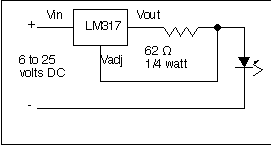7805
- Illuwatar
- Inlägg: 2256
- Blev medlem: 10 november 2003, 14:44:27
- Skype: illuwatar70
- Ort: Haninge
- Kontakt:
Låter lite omständigt att fixa 3.3V med en 5V-regulator. Motstånd är inte den bästa metoden eftersom spänningssänkningen är strömberoende (ohms lag). Dessutom skapas onödig värme på detta sätt. Jag skulle välja en LM317 istället och ställa den på 3.3V alternativt om stora strömmar (> 0.5 A) behövs, använda en regulator ur Simple Switcher-serien (för att hålla förlusterna nere):
http://www.elfa.se/elfa/produkter/se/2001892.htm
http://www.elfa.se/elfa/produkter/se/2001892.htm
- Illuwatar
- Inlägg: 2256
- Blev medlem: 10 november 2003, 14:44:27
- Skype: illuwatar70
- Ort: Haninge
- Kontakt:
Ett sätt att garantera LED'arnas livslängd är att använda en konstantströmsgenerator istället för konstantspänning + motstånd. En sådan ger ut rätt ström oberoende av matningsspänningen och hur många LED's som ligger i serie (begränsas av tillgänglig matningsspänning samt att alla LED's skall köras på samma ström).
-
matseng
- Inlägg: 2360
- Blev medlem: 16 september 2003, 17:18:13
- Ort: Dubai, United Arab Emirates
- Kontakt:
Såhär tillexempel:
http://www.trainweb.org/girr/tips/tips7 ... _tips.html

If a constant current source is what is really desired, then an adjustable voltage regulator circuit, the LM317, can be wired as a current regulator. In this case, the current is set by the 62 ohm resistor. The current will be I=1.25/R. You can also use a LM317L (or the equivalent NTE1900) in a TO-92 package to drive a single diode (or more than one if they are wired in series). The LM317L will run a little hot, but it'll work up to 30 volts input.
If you do run diodes in series, it'll take another 3.4 volts or so of input voltage per extra diode to make the circuit work. This would be an appropriate solution in the case of onboard battery power, DCC or constant track power as there would always be enough voltage to operate the circuit. This configuration allows several diodes (of different types/colors if desired) to share the same 20 mA so that it also minimizes the total current draw.
Don't try to parallel diodes from a current regulator, the diodes will not share current properly unless you add a balancing resistor in series with each diode. In that case, you might as well use the 7805 constant voltage regulator.
http://www.trainweb.org/girr/tips/tips7 ... _tips.html

If a constant current source is what is really desired, then an adjustable voltage regulator circuit, the LM317, can be wired as a current regulator. In this case, the current is set by the 62 ohm resistor. The current will be I=1.25/R. You can also use a LM317L (or the equivalent NTE1900) in a TO-92 package to drive a single diode (or more than one if they are wired in series). The LM317L will run a little hot, but it'll work up to 30 volts input.
If you do run diodes in series, it'll take another 3.4 volts or so of input voltage per extra diode to make the circuit work. This would be an appropriate solution in the case of onboard battery power, DCC or constant track power as there would always be enough voltage to operate the circuit. This configuration allows several diodes (of different types/colors if desired) to share the same 20 mA so that it also minimizes the total current draw.
Don't try to parallel diodes from a current regulator, the diodes will not share current properly unless you add a balancing resistor in series with each diode. In that case, you might as well use the 7805 constant voltage regulator.





